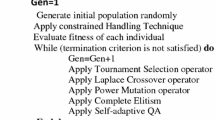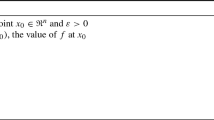Abstract
This paper applies genetic simulated annealing algorithm (SAGA) to solving geometric constraint problems. This method makes full use of the advantages of SAGA and can handle under-/over-constraint problems naturally. It has advantages (due to its not being sensitive to the initial values) over the Newton-Raphson method, and its yielding of multiple solutions, is an advantage over other optimal methods for multisolution constraint system. Our experiments have proved the robustness and efficiency of this method.
Similar content being viewed by others
References
Aldefeld, B., 1988. Variation of geometries based on a geometric-reasoning method.CAD,20(3): 117–126.
Borning, A. H., 1981. The programming language aspects of ThingLab, a constraint oriented simulation laboratory.ACM TOPLAS,3(4): 353–387.
Bose, N. K., 1985. Multidimensional Systems Theory. D. Reidel Publishing Co., p. 184–232.
Bouma, W., Fudos, I., Hoffmann, C. M., Cai, J. and Paige, J., 1994. A geometric contraint solver,CAD.27: 487–501.
Bruderlin, B., 1990. Symbolic Computer Geometry for Computer Aided Geometric Design.In: Advances in Design and Manufacturing Systems, NSF conference, AZ, USA.
Davis, L., 1991. Handbook of Genetic Algorithms. Van Nostrand Reinhold, New York.
David, P. and Borut, Z., 2001. A Geometric Constraint Solver With Decomposable Constraint Set. Skala, V. Eds., The 9th International Conference in Central Europe on Computer Graphics and Visualisation' 01-WSCG'01, Plzen, Czech Republic, University of West Bohemia,2: 222–229.
De Jong, K., 1975. An Analysis of the Behavior of a Class of Genetic Adaptive Systems. PhD Dissertation, University of Michigan. Dissertation Abstract International, 36(10), 5140B. (University Microlms No. 76-9381).
Dennis, J. E. and Schnabel, R. B., 1983. Numerical Methods for Unconstrainted Optimization and Nonlinear Equations. Prentice-Hall Inc., New Jersey.
Durand, C., 1998. Symbolic and Numerical Techniques for Constraint Solving. PhD thesis, Department of Computer Sciences, Purdue University, IN, USA
Durand, C. and Hoffmann, C. M., 1999. Variational Constraints in 3D. Proc. Intl Conf on shape Modeling and Appl, Aizu, Japan, p. 90–97.
Durand, C. and Hoffmann, C. M., 2000. A systematic framework for solving geometric constraint analytically.J. of Symbolic Computing,30: 483–520.
Emiris, I.Z. and Verschelde, J., 1997. How to count efficiently all affine roots of a polynomial system. Discrete Applied Mathematics, 93(1).
Fudos, I., 1993a. Editable Representations for 2D Geometric Design, Master's Thesis, Purdue University, Dept. of Computer Science.
Fudos, I. and Hoffmann, C. M., 1993b. Correctness proof of a geometric constraint solver.Intl. J. Comp Geometry and Applic,6: 405–420.
Fudos, I. and Hoffmann, C. M., 1997. A graph-constructive approach to solving systems of geometric constraints.ACM Transactions on Graphics,16: 179–216.
Ge, J. X., Gao, X. S. and Chou, S. C., 2000. Geometric constraint satifaction using optimization methods.Computer Aided Design,31: 867–879.
Goldberg, D. E., 1989. Genetic Algorithms in Search, Optimization and Machine Learning. Addison Wesley Publishing Company, New York, p. 1–88.
Hoffmann, C. M. and Vermeer, P., 1995a. Geometric Constraint Solving in R2 and R3.In: Computing in Eulidean Geometry Second Edition. World Scientific Publishing, Singapore, p. 266–298.
Hoffmann, C. M. and Vermeer, P., 1995b. A Spatial Constraint Problem.In: Computational Kenematics's 95, J. P. Merlet and B. Ravani, Eds., Kluwer Academic Publ., p. 83–92.
Hoffmann, C. M. and Joan-arinyo, R., 1997. Symbolic constraints in constructive geometry.Journal of Symbolic Computation,23: 287–300.
Hoffmann, C. M. and Yuan, B., 2000. On Spatial Constraint Solving Approaches. Proc. ADG 2000, Springer verlag, ETH, Zurich.
Ivan, S. E., 1963. Sketchpad: A Man-Machine Graphical Communication System.In: Proceedings-Spring Joint Computer Conference, Michigan,23: 329–346.
Joan-Arinyo, R. and Soto, A., 1997a. A correct rule-based geometric constraint solver.Computer and Graphics,21 (5): 599–609.
Joan-Arinyo, R. and Soto, A., 1997b. A Ruler-and-Compass Geometric Constraint Solver.In: M. J., Pratt, R. D., Sriram and M. J., Wozny, editors, Product Modeling for Computer Integrated Design and Manufacture, Chapman and Hall, London, p. 384–393.
Kondo, K., 1992. Algebraic method for manipulation of dimensional relationships in geometric models.CAD,24 (3): 141–147.
Kirkpatrick, S., Gelatt Jr., C. D. and Vecchi, M. P., 1983. Optimization by simulated annealing.Science,220: 671–680.
Lazard, D., 1999. On theories of triangular sets.Journal of Symbolic Computation,28: 105–124.
Michalewicz, Z., Krawczyk, J., Kazemi, M. and Janikow, C., 1990. Genetic Algorithms and Optimal Control Problem.In: Proc. of 29th IEEE Conf. On Decision and Control, p. 1664–1666.
Morgan, A., 1992. Polynomail Continuation and its Relationship to the Symbolic Reduction of Polynomial Systems.In: B. Donal, D. Kapur, and J. Mundy, editors, Symbolic and Numerical Computation for Artificial Inteligence. Academic Press.
Song, P., Tang, M. and Dong, J. X., 2000. A Constraint Solving Approach Based on Graph Decomposition. China Graph'2000, Hangzhou.
Sturmfels, B., 1997. Introduction to Resultants. Lecture Notes at the AMS Short Course on Applications of Computational Algebraic Geometry, San Diego.
Verroust, A., Schonek, F. and Roller, D., 1992. Ruleoriented method for parametrized computer-aided design.Computer Aided Design,24(10): 531–540
Wang, D., 1998. Decomposing polynomial systems into simple systems.Journal of Symbolic Computation,25: 295–314.
Wu, W. T., 1986. Principles of mechanical theorem proving.J. of Automated Reasoning,2: 221–252.
Author information
Authors and Affiliations
Additional information
Project (No. 6001107) supported by the National Science Foundation of Zhejiang Province
Rights and permissions
About this article
Cite this article
Sheng-Li, L., Min, T. & Jin-Xiang, D. Solving geometric constraints with genetic simulated annealing algorithm. J. Zhejiang Univ. Sci. A 4, 532–541 (2003). https://doi.org/10.1631/jzus.2003.0532
Received:
Accepted:
Published:
Issue Date:
DOI: https://doi.org/10.1631/jzus.2003.0532




